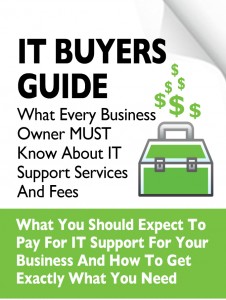Which Flavor Of The Cloud Is Right For You?
 Secure data backup, greater reliability, better resource and growth management options, and improved collaboration are just a few of the reasons to take full advantage of cloud computing today.
Secure data backup, greater reliability, better resource and growth management options, and improved collaboration are just a few of the reasons to take full advantage of cloud computing today.
Yet understanding the choices you have can help you avoid some VERY costly mistakes you could wind up seriously regretting later. To help you move forward with confidence, here are some important points to consider.
Three “Flavors” Of The Cloud
Not all cloud models are the same. A cloud environment that works for a dental practice with a half dozen locations may not be entirely suitable for a new law firm with just a single office.
In determining what the best cloud model is for your organization, it’s important to know how cloud services are structured.
Basically, there are three types of cloud: public, private and hybrid.
Public Cloud Services Offer Flexibility And Lower Cost
A public cloud comprises a collection of data storage and software services that can be accessed on an as-needed monthly basis, somewhat like an electric utility or fitness club. It houses data facilities outside the corporate firewall that you access through an Internet browser without having to make any initial or ongoing capital investment.
Well-known examples of public cloud services include Google Drive, Microsoft Office Online, Apple iCloud and Amazon Cloud Drive. They provide data storage and, in many cases, web apps.
Public clouds are best used where a high level of privacy is not required. They can provide access to a growing pool of newer technologies that would not be affordable if developed individually.
Private Clouds Support Highly Specialized Apps
A private cloud resides within an organization’s firewall, and is typically owned, managed and supported by that business. IT resources are available to members of the organization from their own data center.
Private clouds can support highly specialized and/or privacy-restricted applications, like medical-records software for a health-care organization concerned about HIPAA requirements, for example. And, while it can be more expensive to set up initially, a private cloud may deliver a higher ROI in the long run since you’re not paying for ongoing shared services.
Hybrid Clouds: Balancing Complexity With Flexibility
Merging the flexibility of public cloud services with the control of a private cloud, a hybrid cloud can provide the ideal infrastructure for some organizations.
A hybrid cloud enables you to put some of your apps and data – archives and e-mail, for instance – in a public cloud, and the remainder in your private cloud. This provides the cost savings and benefits of the public cloud while retaining the customization and security advantages of a private cloud.
While it can be more complex to deploy and manage than a pure public or private cloud, a hybrid cloud may deliver the best blend of control, flexibility and cost-effectiveness for some organizations.
So Which “Flavor” Is Right For You?
There is no perfect solution – each type of cloud has its own pros and cons. That being said, here are a few key factors to consider when determining the best approach for your particular business:
Public cloud solutions are best suited to the flexibility and budget requirements of smaller businesses that want access to the kind of IT resources that bigger organizations can afford, without the cost of development and ongoing support and management.
A private cloud, managed and supported by an in-house IT team, may be ideal for your organization if control and privacy are of paramount concern.
A hybrid cloud could be the ideal solution for any enterprise that wants to manage sensitive data in-house while availing itself of third-party software and data storage for uses where the data involved isn’t as sensitive.
How To Get The Best Professional Help
While hiring a cloud-computing expert can prove extremely beneficial in the long run, it’s critical to work with a professional who has depth of experience in all types of cloud environments.
We’ve helped dozens of companies set up and run cost-effective, powerful and secure cloud networks.
For a Free Cloud Readiness Assessment, contact us today at (605) 882-6900 or jeff@BENDIXTechnologyCenter.com.
Forget Something?
A while back I did a huge favor for someone and never heard anything from them… Zip, zilch, nada, nothing. Just a simple “thank you” would have been nice…but they acted as if it was expected of me. To say that I was disappointed is putting it mildly.
To me, disappointed is a very powerful and scary word. You see, disappointed can turn into other “dis” words, such as disgruntled, discouraged, disenthralled, disillusioned, disheartened and possibly even dissatisfied with our current personal or business relationship. I might start noticing that this relationship (business or personal) is really all about YOU and how YOU can benefit; the words reciprocation or gratitude don’t seem to be in your vocabulary.
Everyone likes to be remembered, thanked or appreciated for doing favors, going above and beyond, being courteous, considerate, thoughtful or kind. Being “taken for granted” stinks. Forgetting to show any kind of appreciation for someone who did something for you…that they didn’t have to do…can end up causing you problems later on. You will never know when someday you may need a helping hand, and all those people you took for granted and/or never thanked might NOT be so readily available to help you out.
Francesca Gino, an associate professor at Harvard Business School, did some research on gratitude and looked at 41 fund-raisers at a university, all receiving a fixed salary. The director visited half of the fund-raisers in person, telling them, “I am very grateful for your hard work. We sincerely appreciate your contributions to the university.” The second group received no such expressions of gratitude. What was the impact of the director’s thanks? Gino said that “the expression of gratitude increased the number of calls by more than 50%” for the week, while fund-raisers who received no thanks made about the same number of calls as the previous week.
Organizations and leaders who miss chances to express gratitude lose opportunities to motivate people that actually cost them nothing. Simply stated: gratitude is free and profitable. People may not show that they are upset about not being thanked…but when the time comes for them to help YOU out again, they may just be a little too busy that day. You can transform your relationships, business and personal life with the Power of Gratitude! Never underestimate the power of a thank-you and never pass up on the opportunity to say those two words.
“It is not happy people who are thankful. It is thankful people who are happy.” – Anonymous

Robert Stevenson is a highly sought after, internationally known speaker. He is the author of the best-selling books How to Soar Like An Eagle in a World Full of Turkeys and 52 Essential Habits For Success. Robert is a graduate of the Georgia Institute of Technology (Georgia Tech) and is a former All-American Athlete. He started his first business at 24 and has owned several companies. Robert has international sales experience dealing in over 20 countries, and his client list reads like a Who’s Who in Business. He has shared the podium with such renowned names as Generals Colin Powell and Norman Schwarzkopf, Former President George H.W. Bush, Anthony Robbins and Steven Covey. www.robertstevenson.org/
Shiny New Gadget Of The Month:
New Printer Fits In Your Pocket

So, what’s about the size of a deck of cards and prints instant photos from your smartphone – with no ink needed?
Yes, there is such a thing, and if you guessed the new Polaroid Zip, you’d be right.
Selling for $129.99, it prints full-color 2x3-inch prints with an optional peel-off sticky backing. Each print costs about 25 cents and they look okay, all things considered – just don’t expect ink-jet print quality.
How does it not need ink? It uses Polaroid’s Zink zero-ink paper, embedded with cyan, yellow and magenta crystals. They turn into the appropriate colors when activated by a heat process. And since there’s no ink, there’s no stickiness, smearing or waiting for photos to dry.
More glitches ahead.
Software bugs have been around for a while now. But with so much new technology going online – often without sufficient testing – the interactions are getting harder to predict. A glitch grounded 5,000 United Airlines planes for two hours. Other glitches have halted trading at the New York Stock Exchange. And a glitch at Netflix caused this odd summary: “This Disney film follows a gentle, crippled bell ringer as he faces prejudice and tries to save the eyes of individual dinosaurs.” Unlike software bugs, which can be tested and corrected, glitches happen when technology breaks in unexpected ways. Bottom line? No need to abandon technology – just monitor systems and communicate with IT managers more frequently. -Harvard Business Review
Naturally successful people "sprint," then relax.
An American schoolteacher who moved to Finland in 2014 was skeptical of the Finnish practice of giving students 15 minutes of free time every hour. Until he tried it. He was astounded when they went from dragging their feet to having a bounce in their step and more focus in their studies. The makers of DeskTime, a software that tracks employee time use, studied the habits of the most productive 10% of their 36,000-employee user base. The surprising results? They work for 52 minutes then break for 17 on average. They treat the 52 minutes like a sprint. During the break they tend to go for a walk or tune out, rather than checking e-mail or Facebook. -Reader’s Digest
Your tech: Productive…or distracting?
With constantly evolving technologies, it’s getting harder to know where your time is best spent. To help you stay on track, here are three questions to ask about any situation in your business where technology is involved. 1) Who’s the right person to handle this? For example, let your IT partners help employees with tech support questions. 2) Will this save us time and money? Cloud-based productivity solutions, for example, can give your firm access to the resources of big IT without the need to build it yourself. 3) Is this making your job easier or harder? Syncing devices, for instance, could free you and your sales force from the desk to meet with customers. -Entrepreneur
What’s your business missing by not accepting bitcoin?
Here’s what you need to know: on the plus side, bitcoin allows direct transactions between end users and product or service providers. That makes it fast and free from transaction fees. It’s also extremely difficult to counterfeit, and virtually guarantees user anonymity and security. And promoting that you accept it could enable you to tap into a lucrative demographic. On the other hand, since bitcoins aren’t maintained by a single repository, daily exchange rates can fluctuate rapidly. A bitcoin payment you accepted yesterday could be worth half as much today. That, along with a lack of regulatory oversight and ambivalence toward bitcoin by the U.S. Treasury Dept., suggests a wait-and-see approach. -CBS Pulse
FREE Report:
The Business Owner’s Guide To IT Support Services And Fees

You will learn:
- The 3 most common ways IT services companies charge for their services, and the pros and cons of each approach.
- A common billing model that puts ALL THE RISK on you, the customer, when buying IT services; you’ll learn what it is and why you need to avoid agreeing to it.
- Exclusions, hidden fees and other “gotcha” clauses IT companies put in their con-tracts that you DON’T want to agree to.
- How to make sure you know exactly what you’re getting to avoid disappointment, frustration and added costs later on that you didn’t anticipate.
Claim Your FREE Copy HERE Today


